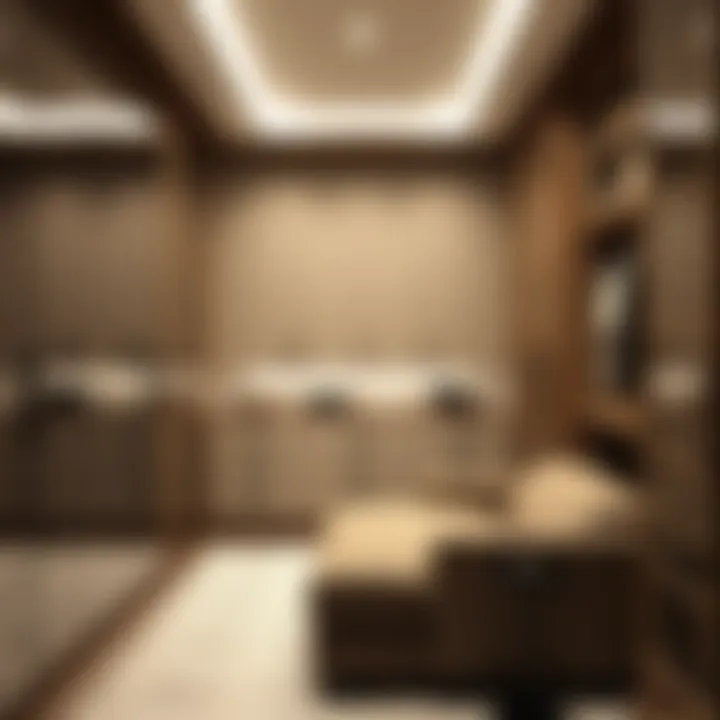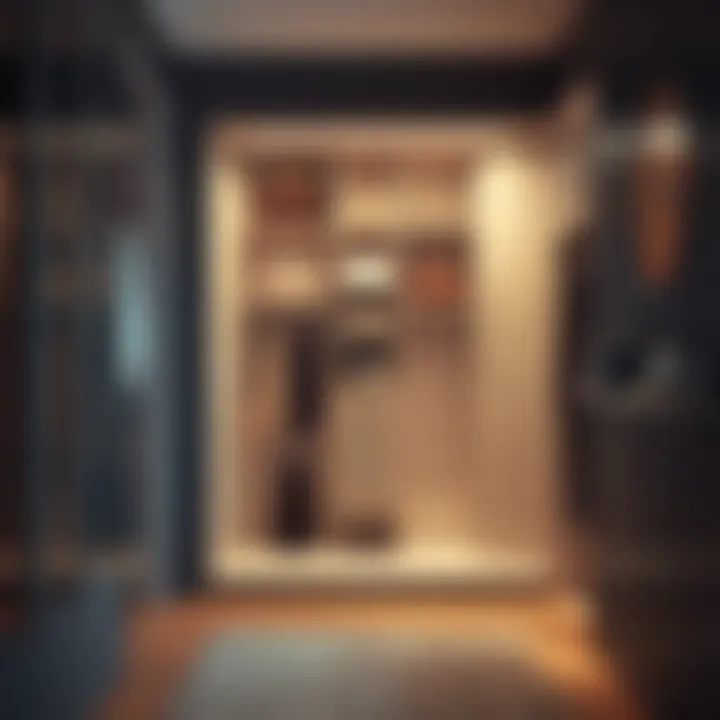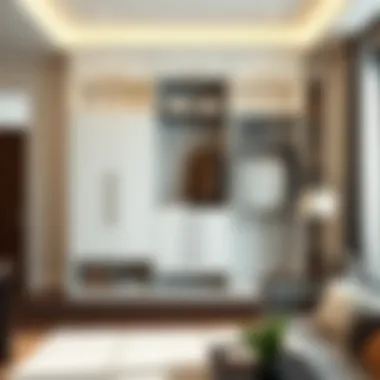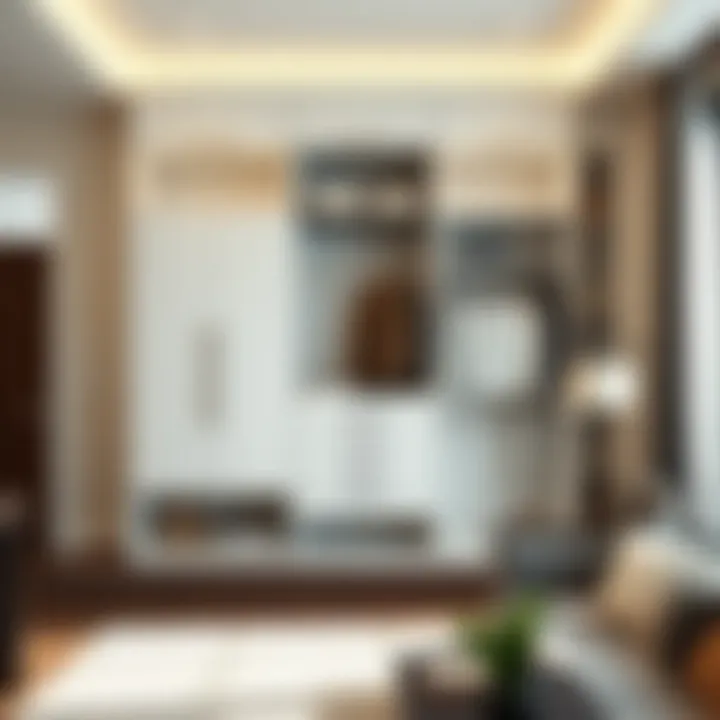Explore Full Wall Closets: Design and Trends


Intro
Full wall closets have shifted from a simple storage necessity to a focal point in interior design. They’re not merely a place to stash away out-of-season clothes or extra linens anymore; instead, they embody a fusion of practicality and aesthetic appeal. This transformation speaks volumes about the changing dynamics of our living spaces, where maximizing efficiency is just as critical as creating a visually pleasing environment. Homeowners and designers alike are exploring the myriad ways these storage solutions can enrich their homes.
By diving into the world of full wall closets, one uncovers an array of designs that cater to individual tastes while being functional. This guide aims to shed light on contemporary styles and even accented vintage inspirations that dictate current trends. Moreover, it will explore innovative materials that complement modern living, including a focus on sustainability and advancements in technology that are reshaping how we think about furniture.
As urban living space gets tighter, particularly in cities, full wall closets offer great potential for enhancing organization and reducing clutter. They can occupy corners, blend into hallways, and utilize vertical space that may otherwise go unappreciated. In this guide, we will dissect the components of these closet systems, pinpoint design trends, and unravel material innovations that have evolved dramatically in recent years.
As we travel through this expansive landscape of design possibilities and practical considerations, it becomes evident that full wall closets are not merely furniture but are indeed an integral part of our personal narratives in interior design.
Understanding Full Wall Closets
Full wall closets serve as essential components in modern interior design. They seamlessly blend functionality with style, offering a solution to one of the most pressing challenges in contemporary living - space management. Notably, understanding the intricate details of full wall closets can help homeowners, designers, and real estate agents alike appreciate the benefits they bring to a property’s overall appeal and functionality. These closets can do more than just store clothes; they hold the potential to transform the very essence of a room.
Definition and Concept
When we talk about full wall closets, we're referencing expansive storage solutions that extend across an entire wall, often integrating various elements like shelving, drawers, and hanging areas into one cohesive unit. This maximizes available space, a critical consideration in urban environments where every square foot matters. Unlike standard wardrobes or dressers, these closets provide a built-in feel that enhances the architecture of a room, while also allowing for personalized designs that fit specific needs.
The concept is rooted in practicality but also extends into the realm of aesthetics. A well-designed full wall closet can elevate the style quotient of a room, contributing to a clean and organized look. Moreover, they can be tailored to match the decor of the home, whether aiming for a sleek modern vibe or a more traditional, classic appearance.
Full wall closets present a systematic approach to storage, making organization second nature. Gone are the days when organizing clothes meant rummaging through cluttered drawers and cramped spaces. With designated sections for shoes, accessories, and seasonal clothing, a full wall closet makes it easier than ever to locate what you need at a moment's notice.
Historical Evolution
The idea of full wall closets isn’t a new trend; it has historical roots that extend back centuries. The evolution began with simple wooden armoires in the 18th century, which were more about functionality than style. As time went on, the industrial revolution brought a boom in furniture design and production, making it possible to create built-in storage solutions tailored to individual homes. In the mid-20th century, as suburban living gained popularity, the concept of maximizing space became paramount, leading to the design of expansive closets that were both practical and stylish.
Today, full wall closets represent the pinnacle of customizable storage. Homeowners have access to various styles, materials, and designs that reflect personal tastes and lifestyles. Changes in societal norms have also influenced these closets; for instance, with more people working from home, there's an increased demand for multifunctional spaces that integrate storage with workspace. Furthermore, the shift towards decluttering and minimalism has inspired many to invest in well-designed closets that promote organization and ease.
Through the years, full wall closets have transitioned from mere storage aids to crucial elements in home design, signaling a blend between function and fashion. Whether for those living in compact apartments or spacious houses, understanding the context and design behind full wall closets can empower homeowners to make informed choices that enhance both functionality and aesthetic appeal.
Types of Full Wall Closets
Understanding the types of full wall closets is crucial in the design and implementation process. This section not only distinguishes the various styles available but also delves into their unique benefits and considerations for homeowners, interior designers, and DIY enthusiasts. Selecting the right type can significantly impact the utility and visual appeal of a space, making this an essential topic for anyone looking to enhance their interior design.
Custom-Made vs. Pre-fabricated
When deciding between custom-made and pre-fabricated full wall closets, it’s like choosing between a handmade suit or off-the-rack. Custom-made closets are tailored exactly to your specifications, offering the chance to utilize every inch of your unique space efficiently. These closets can fit awkward nooks or irregular walls, maximizing functionality. However, they often come at a higher price point and require considerable time for design and installation.
On the flip side, pre-fabricated closets are readily available and can oftentimes be assembled in a jiffy. This option suits those who want a quick fix without diving into a heavy investment. Pre-fabricated units may not fit precisely into an existing space, as their standard dimensions could result in wasted areas. But they can still offer varying styles and finishes to complement a home’s aesthetic while being more budget-friendly.
Built-In vs. Free-standing Designs
Built-in closets are integrated into the structure of the home, creating a seamless look and promoting a cohesive design. These closets typically utilize space more efficiently and can increase the property’s value. However, their permanence means that changes in a room layout can be challenging down the line.
In contrast, free-standing closets boast versatility and mobility. You can rearrange them as needed or take them with you if you move. This flexibility can be particularly useful for renters or those who like to switch up designs frequently. However, they may require more floor space and could disrupt the flow of a room if not selected carefully.
Wardrobe Closets
Wardrobe closets serve as a bridge between function and fashion, offering a designated space for clothing storage that enhances a room’s functionality. Generally taller and deeper than regular closets, wardrobe closets can be standalone units or built-in designs featuring doors that swing or slide open.
The interior can be customized with rods for hanging, drawers for neatly folded garments, or shelves for accessories. This versatility makes them particularly appealing to those who value organization and want to keep clothing visible yet tidy. In a way, wardrobe closets also add a touch of personal flair to a bedroom or dressing area, making it feel more like a boutique.
Sliding Door Closets


Sliding door closets are a game changer in spaces where swing clearance is an issue. These types of closets combine style and practicality by allowing easy access to their contents without requiring any additional space to swing open. The doors can be made of varying materials, such as mirrored glass, which not only help create the illusion of a larger area but add a modern touch.
Moreover, sliding doors can be customized with tracks that accommodate both a classic design and more contemporary aesthetics. It's worth noting, however, that these closets can be less flexible in terms of interior layout, as the sliding mechanism may limit accessible storage options.
Corner Closets
Corner closets are an ingenious solution for maximizing space in often neglected areas. These closets can be built into the corner of a room, taking advantage of otherwise tricky spots. They’re particularly beneficial in smaller rooms, where every inch counts. Typically designed to fit snugly into corners, these closets utilize triangular shelves or rotating systems to effectively use available space.
In terms of aesthetics, corner closets can provide a unique design element, breaking the monotony of straight lines and offering a visually pleasing aspect to a room. When considering corner closets, think about the flow of the room and how they can enhance rather than disrupt the existing layout.
"Choosing the right full wall closet type can turn a chaotic space into an organized sanctuary. Each type has its benefits, tailored to different needs and styles."
Understanding the various types of full wall closets helps in making an informed decision that aligns with both practical needs and personal style, setting the foundation for the design and functionality of your space.
Design Considerations
Understanding the role of design considerations in the context of full wall closets is crucial for homeowners, interior designers, and DIY enthusiasts. These spaces do not merely serve as storage; they represent a significant aspect of interior design that can enhance both functionality and aesthetic appeal. As such, thoughtful design can optimize usability while complementing the overall style of a home.
Space Optimization Techniques
Maximizing space is a common challenge many face when planning closets. Full wall closets can serve as a solution to this issue, provided that they are designed with optimization techniques in mind. A well-planned interior layout can transform even the smallest spaces into functional storage areas.
- Vertical Storage: Utilizing vertical space can dramatically increase storage capacity. Installing upper shelves or moving rods higher allows for the arrangement of less frequently used items on the top while reserving lower spaces for daily wardrobe essentials.
- Adjustable Shelves: These can provide flexibility and adaptability to the closet. Changing the spacing between shelves can accommodate different items, from shoes to bulky winter jackets.
- Corner Solutions: Using corner spaces is often overlooked but can include lazy Susans or angled shelving to make items easily accessible.
Implementing these techniques not only enhances the storage potential but makes the space feel larger and more organized.
Material Selection
Choosing the right materials for your full wall closet is essential as it impacts both function and style. The materials you select can dictate durability, maintenance needs, and of course, the overall look of the closet.
- Wood: A timeless choice, hardwood offers durability and can be stained or painted to match any decor. It conveys an aura of elegance and warmth.
- MDF (Medium Density Fiberboard): More affordable than solid wood, MDF is ideal for painted finishes and delivers a sleek and modern appearance.
- Metal: For a contemporary or industrial look, metal frames and accents can be appealing. They are often seen in boutique-style closets and can be paired with other materials for a mixed look.
- Glass: Incorporating glass doors can create a sense of openness. However, it's important to consider how often items will be accessed as it can require more cleaning of fingerprints and dust.
Selecting materials is not just about the initial impact; it’s also about longevity and ease of use in daily life.
Color Schemes and Aesthetics
Color is another key consideration when designing a full wall closet. The right color scheme can elevate the entire space, blending functionality with aesthetic appeal.
- Neutral Tones: Soft whites, beiges, and grays provide a clean, timeless backdrop that matches with most decors. They can make a space feel larger and are an excellent choice if you plan to sell your home.
- Bold Colors: Bright shades can create a dynamic impact, particularly in larger spaces or for accent features within the closet. These colors can reflect the personality of the occupants and set a distinct tone.
- Textured Finishes: Incorporating textures through materials like rattan, wicker, or patterned textiles can add depth to the design.
A well-thought-out color palette helps to create a cohesive feel not just in the closet, but throughout the entire room.
Remember, the right blend of design considerations ensures that the full wall closet is more than just a storage solution; it becomes a functional piece of your home’s aesthetic.
When you take these elements into account, the result is an organized, elegant, and user-friendly space that serves your needs while enhancing your living environment.
Functional Features
The functional features of full wall closets are what make them not just a storage solution but a transformative element in any space. Beyond merely holding clothes and items, these closets serve as an integral part of a home's layout. When designed with attention to detail, functionality can enhance usability and optimize every square inch of available space. Let’s explore the facets that contribute to their efficiency, their aesthetic appeal, and how they cater to a myriad of storage needs.
Interior Layout Options
When one considers how to maximize the efficiency of a full wall closet, the interior layout is crucial. The organization within can make or break how well it serves its purpose. Effective layout options include:
- Hanging Space: Allocating sufficient room for hanging clothes is essential. Long garments, such as dresses or coats, require a different height compared to shorter items like shirts or blouses. Designing multi-tiered hanging rods can offer flexibility.
- Shelves and Drawers: Adjustable shelves provide the adaptability homeowners crave, allowing for easier changes as clothes and accessories change over time. Conversely, drawers create a tidy solution for smaller items such as socks, ties, or accessories, reducing clutter significantly.
- Dividers and Bins: Utilizing dividers within drawers or open shelf spaces can also enhance organization. Furthermore, bins for seasonal items or seldom-used accessories allow for smart space management.


The key to a successful interior layout is to keep it pragmatic while also allowing the owner to enjoy ease of access. Careful planning goes a long way in ensuring that the closet complements, rather than complicates, daily routines.
Lighting Solutions
A functional full wall closet should never leave you fumbling in the dark, literally and figuratively. Lighting can elevate the user experience and functionality significantly.
- LED Strip Lights: These can be installed along shelving to provide bright, yet subtle illuminations. They can also highlight favorite pieces or important items, turning your closet into more than a storage area.
- Motion Sensor Lights: Installing motion sensors allows for automatic illumination when the door opens. This not only provides convenience but also helps save energy.
- Lighted Closet Rods: For those inclined to see their garments clearly at a glance, lighted rods can serve both practical and aesthetic purposes, enhancing visibility and adding a touch of elegance to the closet space.
"Good lighting can transform even the most mundane of spaces into something inspiring and visually appealing."
Incorporating effective lighting solutions makes a world of difference in functionality, making items easier to find while also adding an element of style that can impress.
Storage Accessories
Accessories are the unsung heroes of any well-organized closet. Thoughtfully chosen storage accessories not only add to functionality but can also improve the look of your full wall closet:
- Hooks and Racks: These are great for versatile storage—not only can they hold scarves and bags, but also hats and belts, providing functionality without overstuffing your closet.
- Shoe Racks and Organizers: A designated area for shoes keeps them looking pristine. Vertical racks or pull-out shoe shelves can save space while providing easy access.
- Carts and Drawers: Portable carts can serve various purposes, from holding current seasonal wear to being a catch-all for miscellaneous items. Stackable drawers also make an efficient use of vertical space.
These accessories should be tailored to the needs of the user, making the closet an effective zone for organization while reducing visual clutter.
In sum, when the functional features of full wall closets are thoughtfully designed, they become a synthesis of usability and aesthetic harmony. This careful blend can provide comfort and satisfaction for homeowners, making everything more accessible and visually appealing.
Trends Influencing Full Wall Closet Designs
The landscape of full wall closet design is an ever-evolving arena, shaped by a multitude of trends that address modern-day needs and preferences. As homeowners seek to merge functionality with aesthetics, these trends cater to a desire for effective use of space without sacrificing style. The importance of integrating current trends into full wall closet designs lies not only in creating stylish storage solutions but also in enhancing the overall value of a home. Let's unpack some of the most significant trends influencing these designs today.
Eco-Friendly Materials
In recent years, eco-conscious living has gained massive traction, and this shift is evident in closet design. Homeowners are becoming increasingly aware of their environmental footprint, thus prompting designers to prioritize sustainable materials. Options such as bamboo, reclaimed wood, and even recycled metal are making waves in full wall closet design.
Using eco-friendly materials offers both aesthetic and functional benefits. Not only do these materials often come with unique textures and colors, but they also contribute to a healthier indoor environment by reducing harmful chemicals typically found in conventional materials. For example, choosing VOC-free finishes can improve air quality in your home.
Moreover, opting for sustainable materials often reflects a homeowner's values, appealing to like-minded buyers when it comes to resale.
Smart Closet Solutions
The advent of technology has introduced a new frontier in closet design known as smart solutions. Innovative features, such as motion-detecting lights and integrated charging stations, offer a dose of luxury and convenience for the modern user. The concept of a connected closet is gaining traction, providing functionalities that go beyond traditional storage.
For example, smart closets can now be outfitted with built-in organizational systems that adjust based on the user’s preferences, optimizing space management. Sensors can even remind users when items have not been worn in a while, suggesting a declutter. This not only promotes a more organized space but can also help individuals understand their consumption habits regarding clothing and accessories.
Minimalist Designs
As attachments to material possessions diminish, the minimalist design trend continues to inspire full wall closet designs. Stripped-back aesthetics emphasize clean lines, simple forms, and a clutter-free environment. The goal here isn’t just to minimize items, but to create a serene atmosphere free from excess.
Achieving a minimalist look can involve opting for built-in solutions that seamlessly blend into the rest of the home. Neutral color palettes, combined with hidden hardware, lend an uncluttered appearance. Spaces that adhere to minimalist principles often feel more expansive, making them especially suitable for smaller homes or urban dwellings.
By employing a minimalist design approach, today’s homeowners can create a space that feels open and airy, even with a full wall closet present.
"A well-designed closet can transform a chaotic room into a sanctuary of order."
Incorporating these trends into full wall closet designs not only enhances their utility but also elevates the overall interior aesthetics of a home. When diving into the realm of closet design, staying abreast of these emerging trends allows homeowners and designers alike to craft spaces that resonate with contemporary living.
Installation and Maintenance
The installation and maintenance of full wall closets can be considered the backbone of their effectiveness and longevity. A well-installed closet, designed with functionality in mind, not only enhances the overall aesthetic of your space but also ensures that it serves its purpose effectively. On the flip side, regular maintenance can extend the life of the closet, making it a wise investment for homeowners and interior designers alike.


Step-by-Step Installation Process
Installing a full wall closet might seem daunting, yet breaking it down into manageable steps can clear a path. To save time and effort, proper preparation is key. Start by measuring your available space accurately. Ensure you have the necessary materials, tools, and a plan. Below is a simplified sequence to guide you through the installation.
- Measurements: Measure your available wall space from floor to ceiling and corner to corner to determine the dimensions of your closet.
- Planning: Sketch a layout considering shelving, hanging rods, and drawer placement based on your wardrobe needs. This blueprint will help visualize the end product.
- Gather Materials: Purchase all necessary materials including shelves, brackets, rods, and fasteners. Don't forget to get the right tools like a drill, level, and screwdriver.
- Mark Wall Studs: Use a stud finder and mark where the studs are located. This is crucial for mounting the shelves securely.
- Assemble the Closet Unit: Follow the manufacturer’s instructions, if applicable, to build the closet unit. Ensure everything fits together without any wobble.
- Mounting: Start by fixing the frame to the wall then add shelves and rods. Make sure to use anchors if the wall material is drywall.
- Final Touches: Adjust the shelves and rods to your liking. This is the time to style it with organizing bins or decorative elements that suit your taste.
Successful installation is both a practical and an artistic challenge, allowing you to create a space that not only meets your storage needs but also complements your home’s overall design.
Preventive Maintenance Tips
Once your full wall closet is installed, maintaining it should become a priority to ensure its functionality remains optimal. Here are some tips to keep your closet in well-kept shape:
- Regular Cleaning: Periodically clear out the closet and dust surfaces. This keeps mold and mildew at bay, especially in humid areas.
- Check Fasteners: Every few months, check screws and fasteners to make sure they remain tight and secure, ensuring your shelves and rods are sturdy.
- Avoid Overloading: Be conscious of the weight limits of shelves and rods. Overloading can lead to structural issues.
- Install Proper Lighting: Adequate lighting can not only enhance visibility but also prevent accidents when searching for items.
- Climate Control: In places with significant humidity, consider using dehumidifiers or moisture absorbers to protect garments stored in the closet.
Ultimately, proactive care can prevent small issues from snowballing into costly repairs. Maintaining your full wall closet contributes to its functionality and longevity, ensuring your investment continues to serve you well.
"Regular check-ups and a little TLC can go a long way in preserving the efficiency of your full wall closet.”
For more insights on closet organization and maintenance, visit Reddit's Home Improvement community or check out resources from Wikipedia.
By keeping your closet well-maintained, you can ensure it not only looks great but also continues to serve its purpose effectively for years to come.
Cost Considerations
Understanding the costs associated with full wall closets is crucial for homeowners, designers, and anyone looking to enhance their living space. This section delves into the financial aspects that influence the design and installation of these storage solutions. By grasping the importance of budgeting and potential return on investment, one can approach the project with clarity and foresight.
Budgeting for Your Closet Project
When planning for a full wall closet, budgeting is the cornerstone of the process. Setting a realistic budget involves several key components:
- Material Choices: The extent of your budget often hinges on the materials selected. Solid wood, melamine, and engineered wood each carry different price tags. If you opt for natural finishes, like oak or cherry, you might be looking at higher costs compared to laminate.
- Installation Fees: Hiring professionals to install your closet can add to your expenses. These services vary widely in price, depending on the complexity of the design and the areas affected. A simple, straightforward installation might not break the bank, but a custom-designed closet with unique features can.
- Accessory Add-ons: Items like pull-out drawers, specialized shelving, or built-in lighting contribute to both functionality and design. However, these accessories can also pile on extra costs. Weighing options based on necessity and personal preference is key.
"Budgeting effectively for a closet project ensures you are not just throwing money at options, but investing in pieces that will truly add value and utility to your home."
In terms of practical steps, create a list of what you want in your closet and research the possible prices for each element. This method allows for adjustments and enables you to prioritize essential features without breaking the bank. A well-done budget can also provide peace of mind, as financial surprises can derail even the best plans.
Value Appreciation in Real Estate
Investing in a full wall closet can be much more than just improving your living space; it can also enhance your property's value. A well-designed and functional closet appeals to prospective buyers, potentially increasing the overall appeal and asking price of the home. Consider the following:
- Market Demand: In many neighborhoods, ample storage solutions rank high on buyers' wish lists. A full wall closet can fulfill this need, making your property more attractive in the competitive real estate market.
- Showcasing Space: An efficient closet design can make a room feel larger and more organized. This aspect can be a significant selling point, particularly in smaller homes or urban apartments where space is at a premium.
- Customization and Luxury: Tailored storage solutions represent a level of luxury that buyers find appealing. Unique designs that offer both functionality and a touch of elegance may command a higher price point than standard setups.
To sum it up, considering costs and value enhances the strategic approach to full wall closet design. The investment not only serves immediate personal needs but can also pay dividends in the real estate market. Taking the time to assess budget components and potential appreciation lays the groundwork for a successful project.
Culmination
Summary of Key Points
In this guide, we’ve traversed the multifaceted world of full wall closets, examining their role as essential storage solutions. Understanding their definition and historical evolution sets a strong foundation for appreciating their significance in modern interiors. The various types of full wall closets, from custom-made options to more affordable pre-fabricated ones, cater to diverse needs and preferences. Design considerations such as space optimization techniques, material choices, and color schemes amplify their appeal, ensuring a thoughtful balance of aesthetics and functionality. Furthermore, the functional features offered, like interior layout options and innovative lighting solutions, enhance the usability of these storage spaces.
One can’t overlook the current trends shaping the industry, from eco-friendly materials to smart closet solutions that cater to the tech-savvy consumer. The insights on installation and maintenance illuminate feasible ways to extend the lifespan and utility of these closets, while understanding cost considerations provides a framework for budgeting wisely, thus ensuring better value retention in real estate investment.
Future of Full Wall Closets
Looking ahead, full wall closets are bound to evolve in response to shifting design paradigms and technological advancements. The continued demand for eco-friendly materials will likely steer manufacturers towards sustainable practices, driving innovation in closet design. Additions such as advanced closet organization systems embedded with smart technology are expected to integrate seamlessly into a homeowner's lifestyle. The minimalist trend, emphasizing simplicity and decluttering, may further push designers to create more streamlined and efficient closet solutions that maximize function without sacrificing style.
The ever-changing landscape of urban living also influences the future of full wall closets. As space becomes a premium commodity, designers will undoubtedly seek creative ways to utilize every inch without making a room feel cramped. This evolution promises to make full wall closets not merely an afterthought but a central element in home design.
Ultimately, as we wrap up this exploration, full wall closets will remain a pivotal component of residential spaces, enriching both functionality and aesthetic appeal. Those looking to enhance their interiors or reconfigure their layouts will find endless possibilities at their fingertips. For more information on modern storage solutions, you can explore resources at Wikipedia, Britannica or community discussions on Reddit.
Ultimately, full wall closets are not only about storage; they're about elevating the entire living experience through smart design and functionality.















